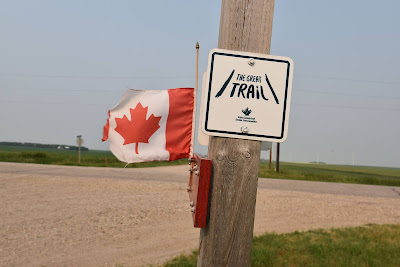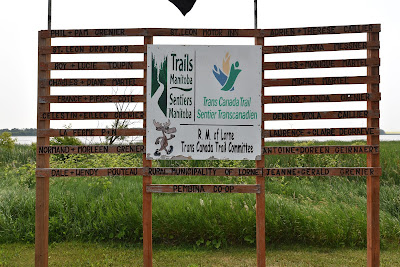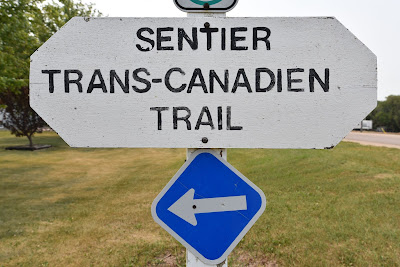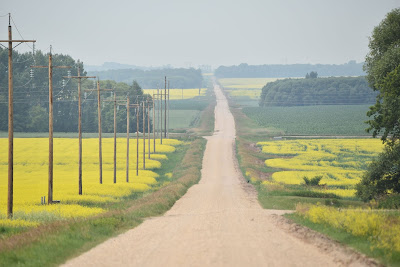Wind Farms and Wild fires : Altamont to Somerset
Today was a short (23 km) hike on the Trans Canada Trail, so perhaps a bit unwisely we slept in to the outrageously late hour of 6:30 am. Our shady campsite was very quiet and peaceful with the exception of a very demanding Yellow-bellied Sapsucker fledgling in the hedge beside us, and it was easy to lie there, enjoying the cool morning air. Unexpectedly, when we finally got up we discovered that the tent was soaked in dew! Yesterday's rain must have made a difference.
As we made our way through town, past the prominent trail sign, George drove up in his truck to make sure we'd had a good night, and to thank us for staying in Altamont. As we walked past the 'Thank you visiting, Please Come Again!' sign we were struck once again by how friendly people are here. These simple messages of thanks and well-wishes might seem cheesy, but they really make a big difference to visitors passing through a community.As we headed south, across the highway and into the fields we discovered a new kind of crop - wind farms! Throughout the day we walked past dozens and dozens of wind turbines, which were rotating rhythmically in the slight breeze. For the first time, in the midst of this quiet and open landscape, we could hear the thrumming noise that seemed to reverberate inside our heads. Interestingly, one of the turbines looked scorched black, and there was a repair crew down below, in the process of raising an enormous crane at its base. The people looked like tiny ants in comparison to the massive structure, giving the vast landscape a curiously unexpected scale.
We later learned that this was the St. Leon Wind Farm, which is the first wind farm in Manitoba. In 2006, sixty wind turbines were erected over a 93 square km area, which were capable of generating 99 megawatts, and in 2011 ten more turbines were added, bringing the capacity up to 120 megawatts.
The landscape we walked through was oddly minimalist, but very beautiful. Large squares of bright yellow canola, dark green soy, and soft waving wheat blanketed rolling hills under a blue sky. The white gravel roads cut neat lines throughout, some of them edged with hydro corridors and wooden utility poles. Above it all a forest of huge white wind turbines stood tall.
The land was very intensively farmed, with the crops extending to the road edges between utility poles, and then arching back in scallop shells around each pole. There were few birds in the fields, except for flocks of Franklin Gulls that were moving around among the small lakes. A highlight was watching a Northern Harrier dive down into a soy field at high speed to capture a small brown mammal, which it carried off in its talons.
About 10 km into our hike we came to the charming francophone town of St. Leon. We had seen several highly decorated Trans Canada Trail markers in the fields along the route, and there was a large 'Sentier Trans Canadien' sign directing us in to town. It was wonderful to see the trail spirit shining so strongly in this area!
The shelter was right on the shores of the lake, and as we rested in the shade we spotted a female Yellow-headed Blackbird foraging on the lawn. We've seen Yellow-headed Blackbirds in several spots, but so far they've successfully avoided being photographed, refusing to emerge from the cattails, so we were very happy with the opportunity to take this one's photo!
As the afternoon progressed the heat picked up, but thankfully the nice cool breeze never stopped. We made our way slowly through the same kind of landscape as this morning, enjoying the vast openness, clean lines, and geometric patterns. Smoke from the forest fires in other parts of Manitoba and northern Ontario hung heavy in the air.
As we made our way north up a straight concession, the wooden utility poles lining both sides making us feel like pin-balls in a chute, we spotted a cairn and a Canadian flag at the side of the road. It seemed like we were in the middle of absolutely nowhere, yet there was a historic marker. Of course, this was why the Trans Canada Trail had selected this particular concession for our perusal. It turned out to be the site of the Theobald School, which was founded in 1879 by the parish priest of St. Leon. In 1918 a new school was built on the site, which was in use until 1959 when the school districts were consolidated. Apart from the cairn there wasn't a single trace of the old buildings left - all the land had been put back into use for crops.
By the early afternoon we reached Somerset, our goal for the night. It features a large campground at the edge of town complete with a playground, splash pad, and washrooms. The town of 432 inhabitants is small, but has a medical clinic, restaurant (sadly closed), hotel, curling rink, skating rink, high school, library, grain elevator, grocery store, and two churches. It also has cell service, which we will need to participate in tonight's Eh Canada Travel Talk Show, where we will get a chance to chat with some of the other Adventure Seekers of Canada.












































Comments
Post a Comment